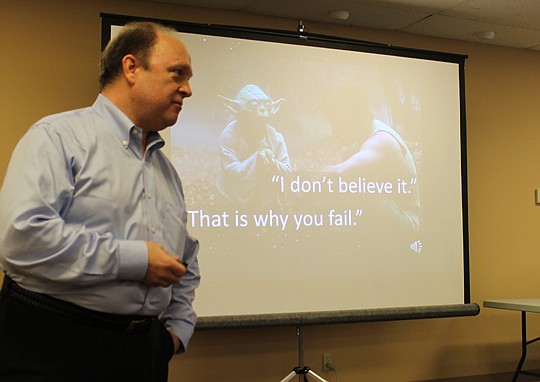
By Carole Hawkins
An agent once told John Palumbo, “There are some funny things going on at my company. I was selling a lot, now I’m not getting any sales.”
He told her he knew why, leaned in and said, “They’re sending the good prospects to the other guy.”
There’s a reason why top producers sell millions, said national marketing guru Palumbo.
“Do not think it’s because they are lucky,” he said. “Do not think it’s because they’re pretty or because they’ve got a connection with somebody.”
They succeed because they have mastered selling’s Jedi mind tricks.
A “sales tune-up” for site agents and Realtors two days before Parade of Homes, Palumbo’s presentation was sponsored by the Northeast Florida Builders Association’s Sales and Marketing Council.
Palumbo’s bag of tricks was tied together by a common thread: To succeed you must master the art of telling a story.
For example, which hitchhiker’s sign moves people more?
Ohio.
Akron or bust.
Or — To Mom’s for Christmas.
Stories draw people in and connect them. “Because we feel stories,” Palumbo said.
A research team bought 129 cheap trinkets from thrift shops and invited several dozen authors to make up interesting stories about them.
They re-sold them on eBay. A globe paperweight bought for $1.49 resold for $197.50. The combined profit for all 129 was $3,612.
Site agents can similarly use stories to infuse customers with the belief there’s something more to their product than just a sticks-and-bricks house, Palumbo said.
“Don’t data dump on your customers, don’t use industry jargon,” he said. “Masters tell stories that are relevant and hold attention.”
Stories have parts. Here’s how they work:
• The tease: It’s the hook that gets your buyer interested in a story.
Some great examples can be found on the morning news: The food in your favorite restaurant could be killing you. Find out more at 7 o’clock.
• Cadence: It’s the rhythmic flow of words, the tone and emotion put into them.
“Tone says what words will not,” Palumbo said. “It’s like opening a bag of dog treats. You sit up and listen.”
Imagine the impact of Martin Luther King’s “I Have a Dream” speech had it been delivered in monotone.
• Disruptive influence: While rhythm draws people into a story, occasional breaks in the rhythm will regain attention.
A good way to disrupt the rhythm is by delivering a surprise. One agent, after spending some time showing a home, would arrive at the kitchen and say, “Every home we sell comes with its own trash compactor.”
Then, he’d take his empty Coke can and smash it underfoot.
• Create urgency: Don’t lie, creating a false urgency, though. Instead, let the customer’s imagination fill in the blanks.
“Am I in competition with anyone else for this house?”
Silence. It will move the customer to his worst fear and propel him more reliably into action.